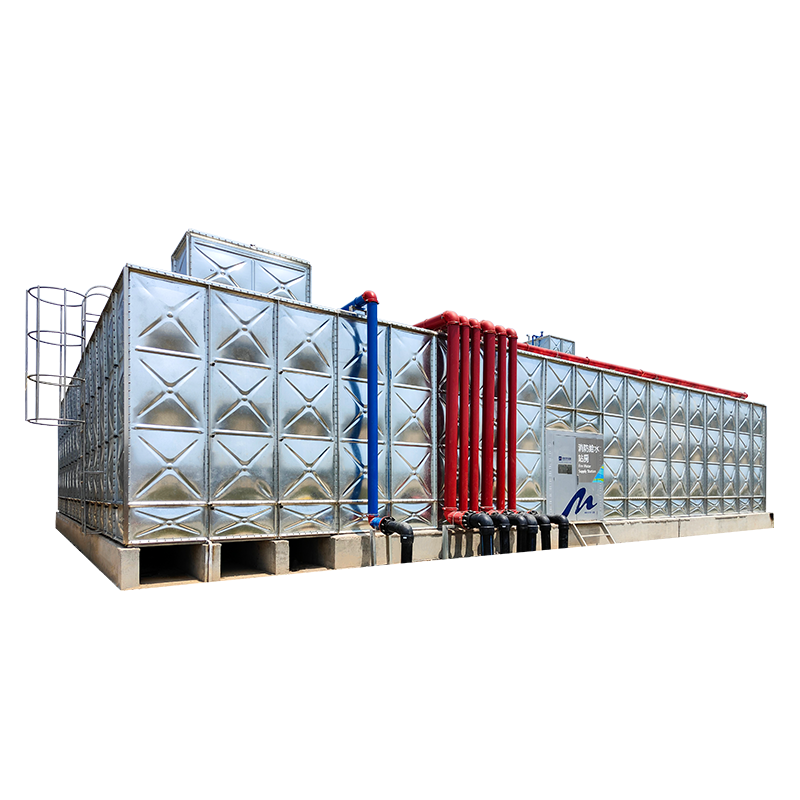Nov 19, 2025
In the world of water storage and supply, selecting the right tank is paramount for longevity, safety, and efficiency. The hot dipped galvanized water tank stands as a robust and time-tested solution for a wide range of applications. This guide delves deep into the specifics of these tanks, exploring their benefits, manufacturing, and ideal use cases, providing you with the essential knowledge for making an informed decision for your water storage needs.
A hot dipped galvanized water tank is a storage container constructed from steel that has undergone a hot-dip galvanizing process. This involves immersing the fabricated steel components into a bath of molten zinc. The result is a metallurgical bond that creates a durable, corrosion-resistant coating, protecting the underlying steel from rust and significantly extending the tank's service life. As a national high-tech enterprise, Jiangsu Mingxing Water Supply Equipment Co., Ltd. integrates this reliable material technology into its comprehensive "smart water supply" solutions, ensuring product durability aligns with intelligent system performance.
Choosing a hot-dipped galvanized tank offers a multitude of advantages that make it a preferred choice for both domestic and industrial applications.
The zinc coating acts as a sacrificial anode, meaning it will corrode before the steel does, offering unparalleled protection even when the coating is slightly scratched.
The robust nature of the zinc-steel bond ensures the tank can withstand harsh environmental conditions, leading to a long service life with minimal maintenance.
Compared to other corrosion-resistant materials like stainless steel, hot-dipped galvanized tanks offer a lower initial investment while still providing excellent performance.
The visual characteristics of the galvanized coating make it easy to inspect for integrity, ensuring ongoing reliability.
When deciding on a water tank material, the choice often narrows down to hot-dipped galvanized steel and stainless steel. Understanding their differences is crucial. The following table provides a clear, sentence-based comparison.
| Feature | Hot Dipped Galvanized Water Tank | Stainless Steel Water Tank |
| Corrosion Resistance | It offers excellent resistance, with the zinc sacrificing itself to protect the steel. | It provides superior resistance to a wider range of chemicals and is inherently rust-proof. |
| Initial Cost | It is generally more cost-effective upfront. | It typically involves a higher initial investment. |
| Maintenance | It requires periodic inspection and potential recoating after many years. | It is virtually maintenance-free under normal conditions. |
| Ideal Use Case | It is perfectly suited for storing potable water, firefighting reserves, and agricultural water. | It is essential for storing aggressive chemicals, in high-purity food processing, or highly corrosive environments. |
Proper maintenance is key to maximizing the lifespan of a hot dipped galvanized water tank. A proactive approach ensures continuous, safe operation.
Conduct bi-annual inspections of the tank's interior and exterior. Look for any signs of white rust (zinc oxide) or, in advanced stages, red rust (iron oxide).
Clean the tank interior periodically to remove sediment and biofilm. Use soft brushes and avoid abrasive materials that could damage the zinc coating.
If small areas of damage to the galvanized coating are found, they can be repaired using a zinc-rich paint to restore protection.
The total cost of hot dipped galvanized water tank installation is influenced by several factors beyond the price of the tank itself.
Larger tanks with higher capacities naturally cost more.
A level, stable concrete foundation is essential, adding to the project cost.
Connecting the tank to existing water lines, pumps, and filtration systems will impact labor and material costs.
While the initial outlay is important, the durability and low maintenance needs of a galvanized tank offer excellent long-term value, reducing the total cost of ownership.
The lifespan of a hot dipped galvanized water tank can easily span several decades when properly specified and maintained.
The thickness and uniformity of the zinc coating are critical. Tanks produced under strict quality control, like those from Jiangsu Mingxing, ensure a consistent protective layer.
Exposure to saline air, industrial pollutants, or acidic rainwater can affect longevity. Positioning and occasional cleaning can mitigate these effects.
The pH level of the stored water is crucial. Highly acidic or alkaline water can accelerate the corrosion process.
The reliability of a hot dipped galvanized water tank makes it an ideal foundation for modern smart water supply networks. Companies like Jiangsu Mingxing Water Supply Equipment Co., Ltd. leverage their expertise in IoT and big data to integrate these durable tanks into intelligent systems. This allows for real-time monitoring of water levels, quality parameters, and system integrity, transforming a passive storage unit into an active, data-generating component of a safe, energy-efficient, and highly manageable water supply ecosystem.

Yes, when used for potable water storage and properly maintained, hot-dipped galvanized tanks are safe. The zinc coating is stable and non-toxic. It is crucial to ensure the tank is new or has only been used for potable water and is cleaned regularly.
The lifespan of a hot dipped galvanized water tank typically ranges from 20 to 50 years, heavily dependent on environmental conditions, water chemistry, and adherence to a proper maintenance guide for galvanized water storage tanks.
Yes, localized rust spots can be repaired. The process involves cleaning the area down to bare metal and applying a zinc-rich primer and paint. For widespread rust, professional assessment is recommended to determine if repair or replacement is more economical.
The primary disadvantage is weight and susceptibility to corrosion if the zinc coating is severely compromised. Plastic tanks are lighter and immune to rust, but they may not offer the same structural strength or longevity as a well-maintained galvanized steel tank.
The robustness, large capacity availability, and proven reliability of hot dipped galvanized water tanks make them ideal for fire protection. They provide a dependable water reserve that can be integrated into smart fire-fighting pump stations, ensuring a ready supply in an emergency.